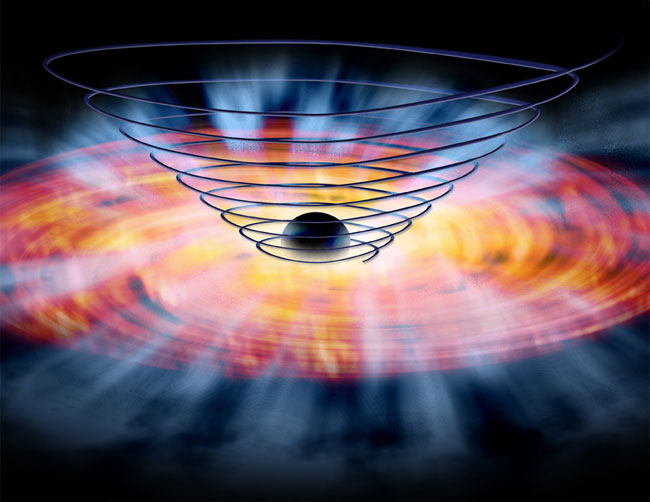Magnetic Fields Nudge Matter Into Black Holes

Black holesare known for their strong gravitational tugs, but gravity alone isn't enoughto send matter tumbling into the center of one.
Magnetismprovides the final nudge, a new study finds.
Theresearch, detailed in the July 22 issue of the journal Nature, confirmsa theory first put forth in 1973 that magnetic fields drive both the infall of matter into black holes and the production oflight energy created by the process.
Gettingrid of angular momentum
A blackhole's gravity is enough to draw matter in and keeps it spinning in a stable"accretion" disk. But before it can take that final plunge, thematerial must lose some of its rotation speed, called angular momentum.
"Manypeople are familiar with the phrase 'bodies at rest tend to stay at rest, andbodies motion tend to stay in motion,'" said study team member Jon Miller,an astronomer at the University of Michigan. "The same thing is true fororbiting bodies--they tend to stay in stable orbits, unless acted upon by aforce."
If angularmomentum from the disk were not dissipated away, gas in the accretion diskwould circle the black hole forever in a stable orbit, like the planets aroundour sun.
Breaking space news, the latest updates on rocket launches, skywatching events and more!
Magnetism'srole
UsingNASA's ChandraX-ray Observatory, the researchers studied GROJ1655-40, a binary system made up of a seven-solar-mass black hole that isstealing gas from the surface of a normal star. The siphoned gas accumulates inan accretion disk around the black hole.
Thespinning gas generates its own magnetic field, and this field powers a "wind"of charged particles blowing away from the black hole.
The wind,which Chandra detected, transfers angular momentum from the inner regions ofthe disk outward. This slows down some of the spinning gas, allowing it to fallonto the black hole. [Click herefor an animation.]
Themagnetic field also causes turbulence and friction to build up within the disk.The friction heats up the gas to millions of degrees, causing it to glowbrilliantly in the ultraviolet and X-raybands.
Anythingwith a disk
Theresearchers believe magnetic fields play an important role in the activities ofblack holes of all sizes, whether they are stellar-mass ones whose accretiondisks are fed by companion stars, or even galaxy-anchoring supermassivemonsters whose disks are formed from the stellar winds of multiple stars.
The findingshould also apply to other objects that have accretion disks, such as neutronstars and whitedwarfs, Miller said.
"Wealready know that disks around some young stars are driven by [magnetic]processes," Miller told SPACE.com. "It would not be a majorsurprise if all accretion disks rely on internal magnetic properties, at leastpartially."
- Black Holes are Actually Green
- Twisted Physics: How Black Holes Spout Off
- Top 10 Chandra Pictures: Four Years of X-ray Imaging
- New Twists on the Milky Way's Big Black Hole
- Chandra Unveils Masked Black Hole
Ker Than is a science writer and children's book author who joined Space.com as a Staff Writer from 2005 to 2007. Ker covered astronomy and human spaceflight while at Space.com, including space shuttle launches, and has authored three science books for kids about earthquakes, stars and black holes. Ker's work has also appeared in National Geographic, Nature News, New Scientist and Sky & Telescope, among others. He earned a bachelor's degree in biology from UC Irvine and a master's degree in science journalism from New York University. Ker is currently the Director of Science Communications at Stanford University.
